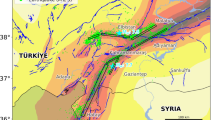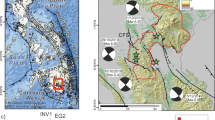Summary
The stress drop and average dislocation of some earthquakes in the Indian sub-continent have been determined after deducing the relationship between the aftershock areaA, and the magnitudeM L of the main shock which is given by
It has been found that the stress drop is considerably larger for the great Assam earthquake of 15 August, 1950, occurring near the continent-continent boundary of the Indian-Eurasian plates, compared to that of a similar magnitude earthquake in a continent-island are type collision boundary in the Pacific (near Japan). The stress drop in smaller events of comparative magnitude in different regions are, however, of the same order and thus do not bring out the distinguishing features of the source regions in different kinds of plate boundaries.
Similar content being viewed by others
References
H. M. Chaudhury, H. N. Srivastava andJ. Subha Rao,Seismotectonic investigations of the Himalayas, inHimalayan Geology, 1974, Vol. IV (Delhi-7) (in press).
M. Ichikawa, H. N. Srivastava andJ. Drakopoulos,Focal mechanisms of earthquakes occurring in and around the Himalayan and Burmese mountain belts, Pap. in Meteor. and Geophys.23 (1970), 149–162.
A. N. Tandon,Anantnag earthquakes (February to April 1967), Ind. J. Met. Geophys.23 (1972), 491–502.
A. A. Nowroozi,Focal mechanism of earthquakes in Persia, Turkey, West Pakistan, and Afghanistan and plate tectonics of the Middle East, Bull. Seism. Soc. Am.62 (1972), 823–850.
T. J. Fitch,Earthquake mechanism in the Himalayan, Burmese and Andaman regions and continental tectonics in Central Asia, J. Geophys. Res.75 (1970), 2699–2709.
A. N. Tandon andH. M. Chaudhury,Konya Earthquake of December 1967, India Meteorological Department, Scientific Report No. 59 (1968).
M. Wyss,Apparent stress of earthquakes on ridges compared to apparent stresses of earthquakes in trenches, Geophys. J. Roy. Astr. Soc.19 (1970), 479–512.
K. Aki,Generation and propagation of G waves from the Niigata earthquake of June 16, 1964. Part 2. Estimation of earthquake moment, released energy and stree-strain drop from the G-wave spectrum, Bull. Earthq. Res. Inst. Tokyo44 (1966a), 73–78.
A. L. Arroyo andA. Udias,Aftershock sequence and focal parameters of the February 28, 1969, earthquake of the Azores-Gibraltar fracture zone, Bull. Seism. Soc. Am.63 (1972), 603–608.
M. Wyss andJ. N. Brune,Seismic moment, stress and source dimensions for earthquakes in the California-Nevada region, J. Geophys. Res.73 (1968), 4681–4694.
T. Utsu andA. Seki,Relation between the area of aftershock region and the energy of main shock, Zisin (ii) (1955), 7.
K. Mogi,Development of aftershock areas of great earthquakes, Bull. Earthq. Res. Inst., Tokyo,46 (1968), 175–203.
M. A. Chinnery,Earthquake magnitude and source parameters, Bull. Seism. Soc. Am.59 (1969), 1969–1982.
V. P. Star,Slip in a crystal and rupture in a solid due to shear, Proc. Camb. Phil. Soc.24 (1928), 489–500.
L. Knopoff,Energy release in earthquake, Geophys. Journ.1 (1958), 44–52.
V. I. Keilis-Borok,On estimation of the displacement in an earthquake source and of source of dimensions, Annal. i Geofis.12 (1959), 204–214.
M. J. Randall,The spectral theory of seismic sources, Bull. Seism. Soc. Am.63 (1973), 133–1144.
K. Iida,Earthquake magnitude, earthquake fault, and source dimensions, J. Earth Sci. Nagoya Univ.13 (1965), 115–132.
S. J. Gibowicz,Stress drop and aftershocks. Bull. Seism. Soc. Am.63 (1973), 1433–1446.
H. Kanamori,Seismological evidence for a lithospheric normal faulting. The Sangriku earthquake of 1933, Phys. Earth & Planet. Interiors4 (1971), 289–300.
P. Molnar, T. J. Fitch andT. Wu,Fault plane solutions of shallow earthquakes and contemporary tectonics in Asia, Earth and Planetary Science Letters12 (1973), 101–112.
Author information
Authors and Affiliations
Rights and permissions
About this article
Cite this article
Tandon, A.N., Srivastava, H.N. The stress drop and average dislocation of some earthquakes in the Indian sub-continent. PAGEOPH 112, 1051–1057 (1974). https://doi.org/10.1007/BF00881507
Received:
Issue Date:
DOI: https://doi.org/10.1007/BF00881507




